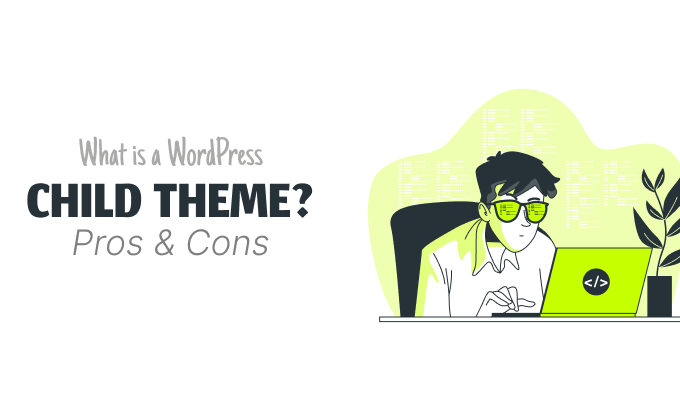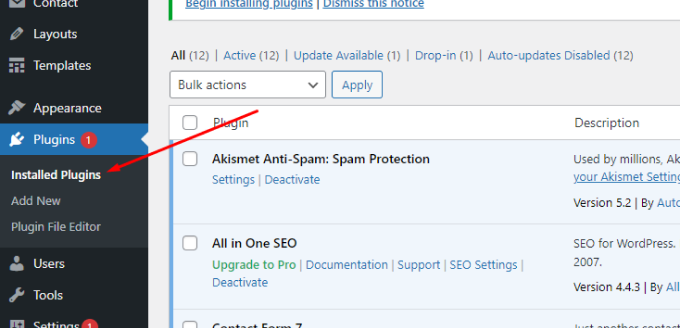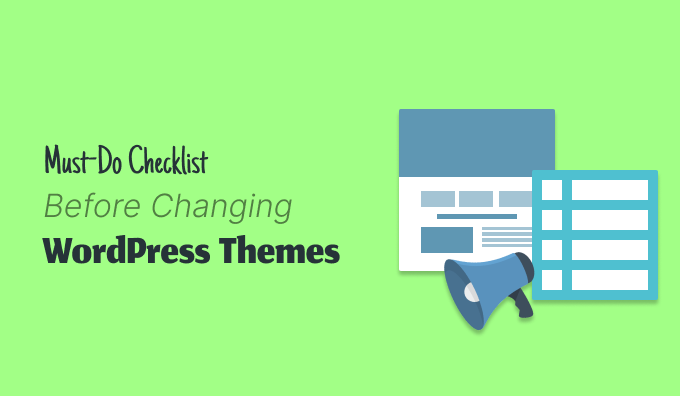
What Is a WordPress Child Theme? Pros, Cons, and More
August 4, 2023
What is Excerpt?
August 8, 2023Curious about the steps to take prior to altering your WordPress theme?
Before making the transition to a new WordPress theme, it's crucial to follow a set of essential actions to guarantee a seamless process and prevent any loss of vital data.
Within this checklist for WordPress users, we'll outline the key tasks you need to complete before switching themes.
Transitioning between themes is a significant choice that website owners typically undertake every few years.
Naturally, you must determine the motivations behind your switch and select a theme that comprehensively fulfills your requirements.
Once you've pinpointed the theme you intend to adopt, it becomes crucial to adhere to the provided checklist. This will guarantee the safeguarding of your content and data throughout the transition process.
1. Make Note of Any WordPress Theme Customizations
Certain WordPress site owners opt to personalize their WordPress themes by directly incorporating code snippets into their theme files. Utilizing code snippets can serve as an effective method to introduce novel functionalities to your website that aren't inherently part of the default theme.
However, when these snippets are inserted directly into your theme files, it can become effortless to misplace or overlook them.
In the event that these modifications were implemented by either yourself or a web developer, it's imperative to meticulously review your existing theme files and document all supplementary code that has been appended.
For future integration of code snippets, we consistently advocate for the utilization of a code snippets plugin like WPCode. This approach enables you to retain these code snippets even if you decide to switch themes down the line. For a more comprehensive understanding, refer to our introductory guide on embedding snippets from the internet into WordPress.
2. Get Current WordPress Theme Performance Metrics
Prior to making any changes to your theme, it's recommended to assess the loading speed and overall performance of your existing website. This evaluation enables you to discern potential disparities in page loading times subsequent to the theme transition.
Given that the speed and performance of your WordPress site significantly influence user experience and SEO outcomes, it becomes crucial to ascertain that the new theme surpasses the speed of your current setup.
To conveniently gauge your current website's speed metrics, you can make use of a WordPress speed testing tool like IsItWP's complimentary website speed testing tool.
For a more comprehensive understanding, refer to our comprehensive guide on executing a website speed test.
3. Make Note of Current Theme Sidebars and Widget Areas
Sidebars serve as designated spaces where you can incorporate a variety of widgets into your website, ranging from email newsletter subscription forms to social media buttons and popular post displays.
Given that the arrangement of widget areas varies across different themes, the widgets on your site might undergo unexpected relocation or disappearance when transitioning between themes.
For this reason, it holds significant importance to compile a record of the widgets integrated into your WordPress sidebars and any other widget zones on your website before embarking on a theme change. This precaution enables you to effortlessly reproduce the same setup after the transition.
Furthermore, if you've implemented any personalized code snippets or shortcodes, it's advisable to duplicate this code and store it in a secure location. This way, you can readily employ it with your new theme.
4. Copy Existing WordPress Tracking Codes
Numerous users opt to embed analytics tracking code directly into their theme files. Additionally, certain WordPress themes offer the convenience of integrating tracking codes within the theme options panel.
Regrettably, it's a common oversight to disregard the significance of these crucial tracking codes.
To mitigate this oversight, it's essential to meticulously gather all tracking codes employed for analytics, advertising, and related purposes on your current website. This compilation ensures a seamless transition when incorporating them into your new website.
5. Back Up Your Current WordPress Website
Maintaining a consistent practice of website backups is a prudent course of action. Prior to altering your theme, it's essential to conduct a comprehensive backup of your posts, pages, plugins, media, and databases.
The simplest approach involves utilizing a WordPress backup plugin to generate a complete backup of your entire site.
Our recommendation is to employ the Duplicator plugin, which not only facilitates the creation of automated and scheduled backups but also permits you to store them on cloud storage platforms such as Dropbox and Google Drive, among others.
Duplicator offers a free version as well, which serves as an excellent starting point. To delve into the specifics, consult our comprehensive guide on the process of backing up a WordPress site.
This precautionary step ensures seamless recovery options in the event of any complications arising during the theme transition process.
6. Put Your WordPress Site Into Maintenance Mode
When implementing modifications to your website, it's consistently advisable to activate maintenance mode. This mode allows you to exhibit a user-friendly notification to your site's visitors.

This strategy effectively shields your visitors from encountering your website while it's still a work in progress or undergoing construction.
7. Test All Functionality and Installed WordPress Plugins
Upon successfully activating your new WordPress theme, it's essential to verify the continuity of your previous functionality and the compatibility of your existing plugins with the new theme.
Begin by reintroducing the code snippets you had transferred from your previous WordPress theme files. For in-depth instructions, consult our beginner's guide on inserting code snippets into WordPress.
Subsequently, dedicate time to exploring the functionalities of your site that rely on WordPress plugins. Should you encounter any issues during this process, refer to our beginner's guide on addressing WordPress errors for effective troubleshooting.
8. Test New WordPress Theme Across Browsers and Devices
Conducting cross-browser testing is crucial to ensuring the optimal appearance of your new website across various browsers, screen dimensions, operating systems, and mobile devices.
While a significant portion of your visitors might favor Google Chrome for accessing your WordPress blog, it's worth noting that other browsers like Firefox, Microsoft Edge, Safari, and others continue to be utilized by millions of users worldwide.
Neglecting compatibility with these browsers could result in missed opportunities for engaging visitors and capturing traffic.
Thankfully, an array of cross-browser testing tools is available to assess your website's presentation across diverse browsers and devices.
For comprehensive insights, refer to our guide detailing the process of testing a WordPress site across different browsers.
9. Delete WordPress Plugins You No Longer Need
Certain WordPress themes include pre-installed plugins alongside the theme installation. While a few of these plugins might prove beneficial, there could be instances where they are unnecessary.
To determine whether your theme has introduced any additional plugins, navigate to the Plugins section and click on Installed Plugins.

This is also an opportune moment to review your complete list of plugins and consider removing any that may no longer serve a purpose.
If you're searching for top-notch plugins to complement your new theme, take a look at our selection of essential WordPress plugins.
10. Let Your Users Know Your New Website is Live
When you're prepared to launch your new WordPress theme, it's time to deactivate the maintenance mode.
Furthermore, it's advisable to reach out to your readers and inform them about your updated website. This proactive step will ensure that your audience is well-informed about significant design alterations, reducing any potential confusion. Moreover, it will contribute to maintaining the engagement of your subscribers, encouraging them to revisit your site to witness the fresh design.
We suggest informing your audience through channels such as your email newsletter, social media platforms, and push notifications.
For additional strategies to enhance your website's promotion, refer to our comprehensive guide on effectively sharing your blog posts with your readers.
11. Test Loading Speeds for Your New WordPress Theme
After successfully launching your new theme and completing the aforementioned procedures, it's advisable to conduct another speed assessment. Ideally, your updated website should exhibit enhanced speed and achieve improved scores in the speed test.
To achieve this, employ the same website speed assessment tool you utilized previously and juxtapose the outcomes.
Should your new theme prove to be slower compared to the previous one, take the initiative to run multiple tests, carry out evaluations from diverse geographical locations, and inspect whether any caching or firewall configurations might be contributing to the decline in speed.
If you found this article helpful, we invite you to subscribe to our YouTube Channel for more WordPress video tutorials. You can also connect with us on Facebook for additional updates and content.





